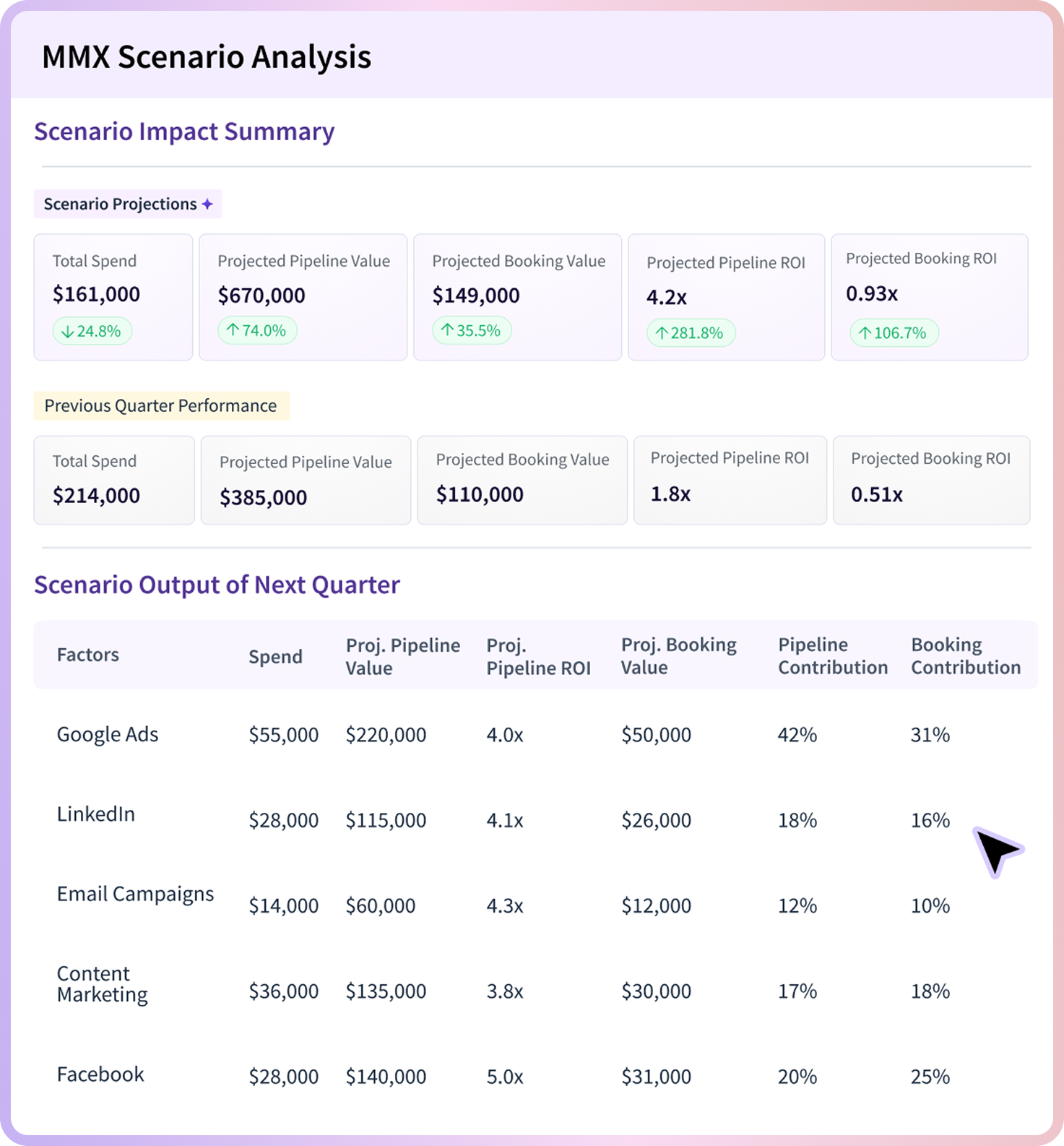For years, GTM planning has revolved around dashboards, forecasts, and static reports- snapshots of what has already happened or might happen if current trends continue. Useful? Sure. Dynamic? Not at all.
Markets shift weekly. Pipeline health evolves continuously. Yet most plans are still updated quarterly. That gap between visibility and adaptability is where opportunity is lost. To thrive in today’s GTM environment, teams need more than historical insight; they need decision agility. They must understand, in real time, how potential moves, campaign pivots, budget reallocations, or resource shifts will affect the future pipeline before they act.
That’s the leap AI-powered scenario modeling enables. It transforms planning from a backward-looking reporting exercise into a continuous simulation engine, one where every change is tested before it’s made.
Why Traditional Planning Breaks Down
Even the most sophisticated GTM teams rely on rigid planning cycles. Forecasts are reviewed quarterly, budgets are adjusted mid-year, and by the time updates reach execution teams, the market has already changed.
Traditional planning fails because:
- Forecasts lag reality. They’re based on past assumptions, not current signals.
- Scenarios are manual. By the time analysts model alternatives, the data is stale.
- Insight and execution are disconnected. Teams can see the problem but can’t act quickly enough to fix it.
The result? GTM organizations end up reacting to change instead of anticipating it; a critical disadvantage in volatile markets where every week of inaction compounds risk.
Predictive AI as a Planning Copilot
Predictive AI redefines GTM planning by introducing speed, simulation, and precision into decision-making. Instead of simply predicting what will happen, AI models multiple potential futures and evaluate which is most likely to succeed.
Rather than asking, “What’s our forecast?”, leaders can now ask, “What if we shift spend today, how will that impact pipeline, ROI, and revenue?” Predictive AI doesn’t replace human planning judgment; it enhances it with probabilistic precision. It becomes a copilot that continuously tests assumptions, recommends adjustments, and quantifies trade-offs.
Let’s look at how this works in practice.
How Scenario Modeling Works in Practice
Imagine it’s mid-quarter and pipeline coverage in EMEA is slipping below target. Instead of waiting for a quarterly review, your predictive copilot is already running live simulations. It evaluates key dimensions such as spend efficiency, conversion velocity, engagement surges, and forecasted contribution over time intervals.
In seconds, it models multiple potential courses of action, such as reallocating 10% of EMEA’s paid search budget to regional events, shifting APAC investment to top-performing digital campaigns, or pausing in saturated markets to focus on early-stage awareness.
Each scenario is simulated for likely outcomes: revenue uplift, ROI variance, and coverage improvement, and prioritized automatically. What once took days of manual modeling now occurs continuously and autonomously, allowing GTM teams to see the impact of their decisions before executing.
The Strategic Advantages of Scenario-Based Planning
AI-driven scenario modeling doesn’t just make planning faster; it changes how GTM teams operate. Plans evolve instantly as new signals surface, trade-offs are made with confidence, and every department works from a single version of truth.
When volatility hits, adaptive plans anchored in simulation maintain continuity and predictability. Instead of defending static quarterly models, GTM leaders can design frameworks that learn and evolve in motion. Every decision becomes a hypothesis, and every outcome adds intelligence to the next.
That’s the difference between teams that react to change and those that simulate it, between organizations that report performance and those that continuously improve it.
What It Takes to Make Scenario Modeling Work
Predictive AI can only model what it understands. That’s why data foundations determine whether scenario modeling succeeds or fails. To make AI scenario modeling work at scale, GTM teams must invest in three essentials:
- Unified, high-quality data ensures simulations reflect reality by maintaining continuous access to clean and complete pipeline, marketing, and engagement data.
- Defined modeling boundaries prevent unrealistic or unexecutable recommendations, keeping AI outputs practical and trustworthy.
- Governed experimentation introduces controlled feedback loops that test, validate, and refine AI recommendations over time.
Together, these elements turn AI from a passive reporting engine into a trusted strategic partner, one that can act, adapt, and advise with accountability.
RevSure Scenario Planner: Turning Insight into Foresight
RevSure’s Marketing Mix (MMX) Scenario Planner takes the guesswork out of planning by showing how different spending choices could shape your pipeline and bookings before you ever spend a dollar.
Think of it as a marketing finance lab that lets you experiment safely. You can model multiple spending scenarios, like what happens if you cut LinkedIn investment by 20% or shift more budget toward Google, and immediately see how those decisions change your projected pipeline and bookings.
It doesn’t stop at experimentation. The MMX Scenario Planner helps you understand saturation points; the point at which adding more budget to a channel stops improving ROI. You can compare new plans against the previous quarter to measure improvement and identify which changes actually move the needle.

Once you’ve modeled your scenarios, the Scenario Impact Summary visualizes the full picture: total spend, projected pipeline and bookings, and the ROI implications of each move. In seconds, you can see whether your new mix delivers more revenue at a lower cost.

From there, you can dive deeper into feature-level insights across every channel, from content syndication and paid search to offline events, and instantly see how each tactic contributes to spend, pipeline, and bookings.
From Forecasting to Forward Motion
The future of GTM planning isn’t about creating more dashboards; it’s about creating decision momentum. Predictive AI acts as a copilot that models outcomes, tests assumptions, and guides direction in real time. It doesn’t replace human strategy; it amplifies it with speed, accuracy, and foresight.
Teams that embrace scenario-based planning move beyond reactive forecasting to proactive orchestration, where every decision compounds learning rather than risk. The best GTM planners won’t be those who predict the future flawlessly; they’ll be the ones whose plans adapt intelligently as they unfold.
Related Blogs







